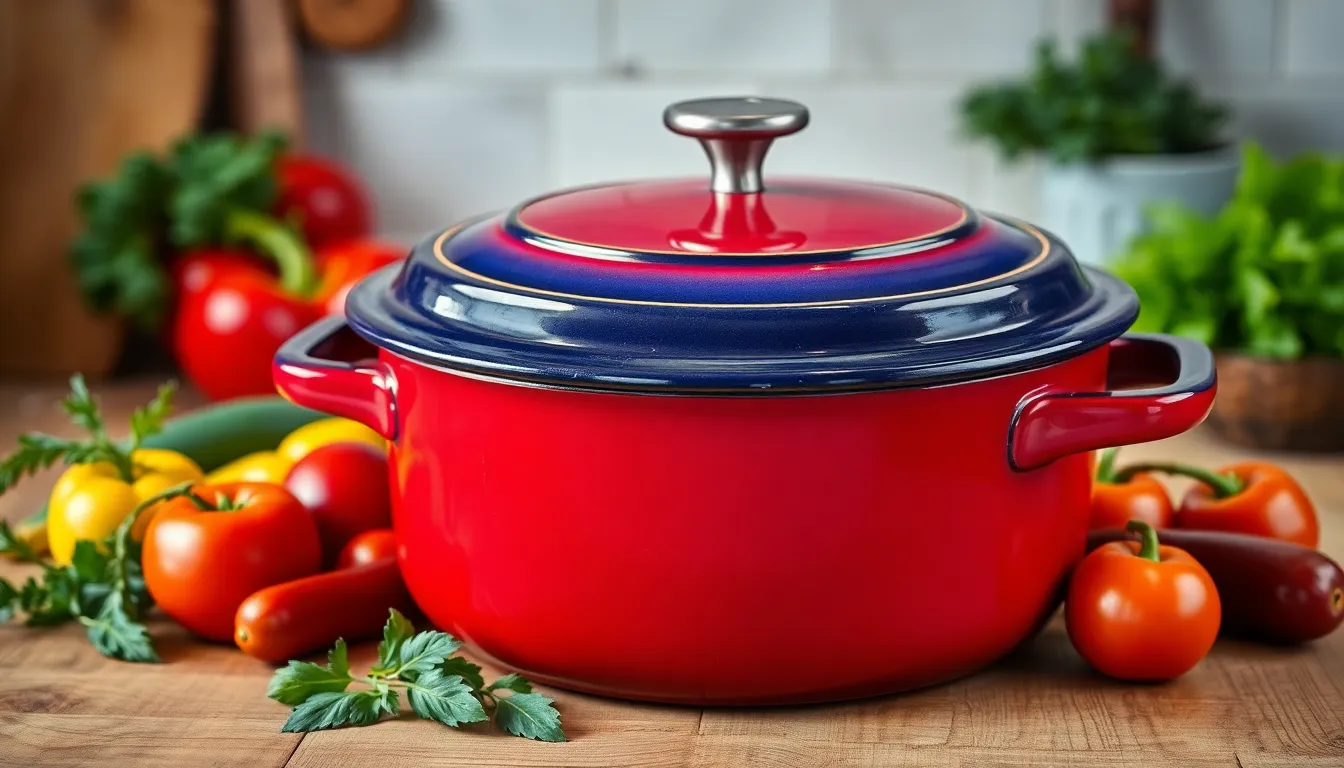Imagine a kitchen superhero that can braise, bake, and simmer like a pro—all while looking fabulous on your countertop. Enter the Dutch oven, the versatile cooking vessel that’s been winning hearts (and stomachs) for centuries. Whether it’s a cozy stew or a crusty loaf of bread, this heavy-duty pot is ready to tackle any culinary challenge thrown its way.
But don’t let its humble appearance fool you; the Dutch oven is the secret weapon of home cooks and professional chefs alike. With its ability to retain heat and distribute it evenly, it transforms simple ingredients into mouthwatering masterpieces. So, if you’re ready to elevate your cooking game, grab a Dutch oven and get ready to impress your taste buds—and maybe even your dinner guests. Who knew a pot could be this much fun?
Table of Contents
ToggleWhat Is a Dutch Oven?
A Dutch oven is a heavy pot, typically made of cast iron, designed for slow cooking and baking. This versatile kitchen tool excels at various cooking methods, including braising, simmering, and baking.
History of Dutch Ovens
The term “Dutch oven” dates back to the 18th century. Early examples originated in the Netherlands, where innovative casting techniques allowed for high-quality cookware. American colonists adopted these cooking pots, and by the early 1900s, they gained popularity in the United States. Throughout the years, manufacturers improved the design, including enameled finishes, leading to modern versions that enhance performance while being aesthetically pleasing.
Common Features
Dutch ovens are characterized by their thick walls and tight-fitting lids. These features help retain heat and moisture during cooking, ensuring even temperature distribution. Many models come with a heavy base, which prevents scorching. Additionally, enameled coatings simplify cleaning while preventing rust. Handles on the sides facilitate lifting and carrying, enhancing ease of use in various cooking scenarios.
Benefits of Using a Dutch Oven

A Dutch oven offers numerous advantages that make it a valuable addition to any kitchen. Its ability to excel in various cooking methods sets it apart from other cookware.
Versatility in Cooking
One key benefit of a Dutch oven is its versatility in cooking. It supports techniques such as braising, baking, stewing, and frying. Home cooks and professional chefs appreciate its suitability for stovetop and oven use. This adaptability allows for a wide range of recipes, from hearty casseroles to artisan bread. A single pot can handle different ingredients, making meal preparation efficient. Simple ingredient transformations into elaborate dishes become easy, with minimal cleanup required after cooking.
Heat Retention and Distribution
Heat retention and distribution stand out as two essential features of a Dutch oven. Thick walls ensure even heating, eliminating hot spots that often lead to uneven cooking. Cast iron construction retains heat effectively, allowing for slow and consistent cooking. Products with enameled finishes enhance heat distribution, further improving performance. This steady heat works wonders for simmering soups and braising meats. Furthermore, the tight-fitting lid traps moisture, resulting in tender and flavorful meals that showcase the quality of ingredients used.
Types of Dutch Ovens
Dutch ovens come in various materials and designs, each catering to specific cooking needs and preferences. Understanding these options helps in selecting the right oven for culinary endeavors.
Material Options
Cast iron is the most common choice for Dutch ovens. Its exceptional heat retention and distribution make it ideal for slow cooking. Enameled cast iron enhances performance and eases cleanup, adding a protective layer that prevents rust. Stainless steel Dutch ovens also exist; they offer durability and resistance to corrosion while maintaining even heat. Some Dutch ovens come with non-stick finishes, simplifying the cooking process for delicate foods. Each material serves unique culinary purposes while ensuring a satisfying cooking experience.
Size and Shape Variations
Sizes of Dutch ovens range from small (2-quart) to large (10-quart or more), accommodating different portion sizes. A medium-sized oven (5 to 7-quart) fits standard family meals while larger options cater to gatherings or meal prepping. Shapes vary too; round and oval designs exist to fit various stovetop and oven configurations. Round Dutch ovens excel in even cooking, while oval versions accommodate larger roasts and turkeys. Choosing the right size and shape ensures efficiency and satisfaction in every dish prepared.
How to Choose the Right Dutch Oven
Choosing the right Dutch oven involves considering several key factors. Understanding individual cooking needs and budget constraints ensures a suitable selection.
Consider Your Cooking Needs
Identify intended cooking methods to determine which Dutch oven fits best. Those who prefer slow cooking benefit from heavy, cast iron models. Individuals interested in baking might favor enamel-coated options for easier cleanup. Consider size requirements based on frequent meal portions; smaller 2-quart Dutch ovens serve one or two people while larger 10-quart models cater to family gatherings. Select between round and oval shapes; round designs provide even heat distribution, whereas oval shapes accommodate larger cuts of meat. Evaluate features like handles and lids; sturdy handles make for easier transport, and tight-fitting lids enhance moisture retention.
Budget Considerations
Set a budget before exploring Dutch oven options. Prices typically range from $30 for a basic stainless steel model to $300 for high-end, enameled cast iron versions. Quality impacts durability and performance; investing more often leads to long-lasting cookware. Compare options from various brands to find a balance between price and quality. Examine warranty information; some manufacturers offer lifetime guarantees, indicating confidence in their product. Keep in mind that higher-priced Dutch ovens usually come with better heat retention and versatility, making them a worthwhile investment for serious cooks.
Tips for Using and Maintaining a Dutch Oven
Utilizing a Dutch oven can elevate cooking techniques and enhance flavors in various dishes. Knowing how to use this versatile tool effectively leads to satisfying results.
Cooking Techniques
Braising benefits greatly from the Dutch oven’s heat retention. Slow-cooking tough cuts of meat results in tender and flavorful dishes. Baking bread in a preheated Dutch oven creates a crusty exterior while maintaining a soft interior. Moreover, simmering soups and stews allows for the flavors to meld beautifully. Roasting vegetables in the Dutch oven ensures even cooking, bringing out their natural sweetness. Each technique leverages the pot’s ability to conduct heat, making it an essential tool in any kitchen.
Cleaning and Care
Maintaining a Dutch oven prolongs its life and ensures optimal performance. Cleaning should be done with warm water and mild soap; avoid abrasive scrubbers that might damage the surface. After each use, ensure it’s completely dry to prevent rusting, particularly for cast iron models. Seasoning the interior maintains its non-stick properties and improves durability. Store the Dutch oven with the lid slightly ajar to allow air circulation. Regular care guarantees that it remains a reliable kitchen companion for years to come.
The Dutch oven stands out as a must-have tool for any kitchen. Its remarkable versatility allows for various cooking techniques that can elevate everyday meals into culinary masterpieces. With options ranging from traditional cast iron to modern enameled finishes, there’s a Dutch oven to fit every cook’s needs and preferences.
Investing in a quality Dutch oven not only enhances cooking experiences but also ensures durability and performance for years to come. By understanding the different types and features available, anyone can find the perfect Dutch oven to suit their culinary journey. With proper care and maintenance, this timeless cookware will continue to inspire delicious creations and memorable meals.







